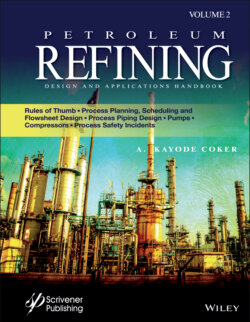Читать книгу Petroleum Refining Design and Applications Handbook - A. Kayode Coker - Страница 31
MIXING AND AGITATION
Оглавление1 1. Mild agitation is obtained by circulating the liquid with an impeller at superficial velocities of 30.48–60.9 mm/s (0.1–0.2 ft/s), and intense agitation at 213.4–304.8 mm/s (0.7–1.0 ft/s).
2 2. Intensities of agitation with impellers in baffled tanks are measured by power input, hp/1000 gal., and impeller tip speeds:Operationhp/1000 gal.Tip speed (ft/min)Tip speed (m/s)Blending0.2–0.5Homogeneous reaction0.5–1.57.5–100.038–0.051Reaction with heat transfer1.5–5.010–150.051–0.076Liquid–liquid mixtures515–200.076–0.10Liquid–gas mixtures5–1015–200.076–0.10Slurries10
3 3. Proportions of a stirred tank relative to the diameter D: liquid level = D; turbine impeller diameter = D/3; impeller level above bottom = D/3; impeller blade width = D/15; four vertical baffles with width = D/10.
4 4. Propellers are made with a maximum of 457.2-mm (18-in.) turbine impellers to 2.74 m (9 ft).
5 5. Gas bubbles sparged at the bottom of the vessel will result in mild agitation at a superficial gas velocity of 0.0051 m/s (1 ft/min), severe agitation at 0.02 m/s (4 ft/min).
6 6. Suspension of solids with a settling velocity of 0.009 m/s (0.03 ft/s) is accomplished with either turbine or propeller impellers, but when the settling velocity is above 0.05 m/s (0.15 ft/s) intense agitation with a propeller is needed.
7 7. Power to drive a mixture of a gas and a liquid can be 25–50% less than the power to drive the liquid alone.
8 8. In-line blenders are adequate when a second contact time is sufficient, with power inputs of 0.1–0.2 hp/gal.
